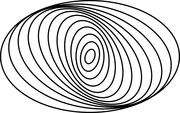Spiral galaxy
|
|
A spiral galaxy is a type of galaxy in the Hubble sequence which is characterized by the following physical properties:
Galaxy.m74.arp.750pix.jpg
- A considerable total angular momentum
- Composed of a central bulge surrounded by a disk
- The bulge resembles an elliptical galaxy, containing many old, so-called "Population II" stars, and usually a supermassive black hole at its center.
- The disk is a flat, rotating assembly consisting of interstellar matter, young "Population I" stars and open star clusters.
Spiral galaxies are so named due to the bright arms of star formation within the disk that extend—roughly logarithmically—from the bulge. Though sometimes difficult to discern, such as in flocculent spirals, these arms distinguish spiral galaxies from their lenticular counterparts, which exhibit a disk structure but no evident spiral.
The disks of spiral galaxies tend to be surrounded by large spheroid halos of Population II stars, many of which are concentrated in globular clusters that orbit the galactic center.
Our galaxy, the Milky Way, is a spiral, with a Hubble sequence classification of Sbc (possibly SBb).
Origin of the spiral structure
The early pioneer of studies on the formation of the spiral arms was Bertil Lindblad. He realised that the idea of stars arranged permanently in a spiral shape was untenable due to the "winding dilemma". Since the speed of rotation of the galactic disk varies with distance from the centre of the galaxy, a radial arm (like a spoke) would quickly become curved as the galaxy rotates. The arm would, after a few galactic rotations, become increasingly curved and wind around the galaxy ever tighter. This is not what is observed.
The first acceptable theory was devised by C. C. Lin and Frank Shu in 1964. They suggested that the spiral arms were manifestations of spiral density waves. They assumed that the stars travel in slightly elliptical orbits and that the orientations of their orbits is correlated i.e. the ellipses vary in their orientation (one to another) in a smooth way with increasing distance from the galactic centre. This is illustrated in the diagram. It is clear that the elliptical orbits come close together in certain areas to give the effect of arms. Stars therefore do not remain forever in the position that we now see them in, but pass through the arms as they travel in their orbits.
Alternative hypotheses that have been proposed involve waves of star formation moving about the galaxy; the bright stars produced by the star formation die out quickly, leaving darker regions behind the waves, and hence making the waves visible.
See also
External links
- Spiral Galaxies @ SEDS Messier pages (http://www.seds.org/messier/spir.html)ca:Galàxia espiral
fr:Galaxie spirale it:Galassia spirale ja:渦巻銀河 sk:Špirálovitá galaxia fi:Spiraaligalaksi

